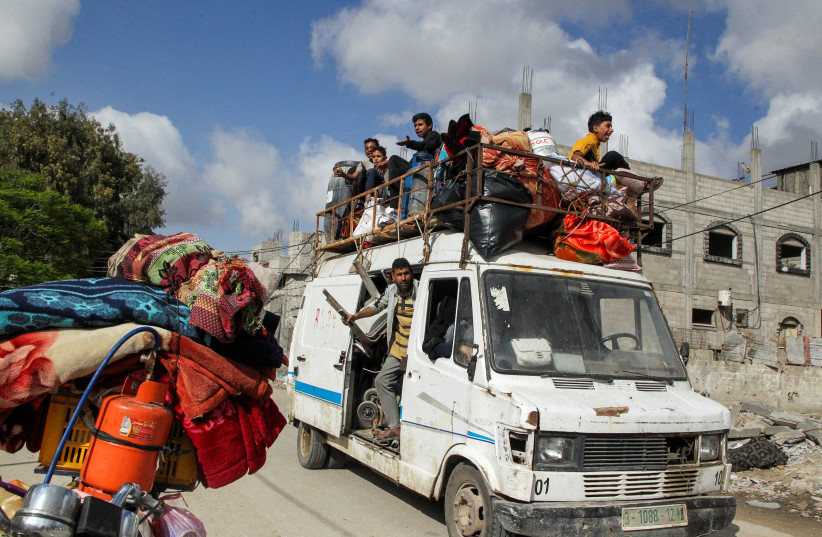All eyes are focused on Rafah as IDF moves forward
The battle for Rafah is becoming the crucible through which the Gaza war is now passing, in which a new stage of the war may become apparent. The battle for Rafah has been brewing for months as Israel set its eyes on the southern Gaza city.
This has made the city of more international importance because many countries warned Israel against this operation. Israel proceeded anyway, sending tanks to seize the Rafah crossing on May 7. Now, more than two weeks into the battle, foreign reports say tanks have reached an area near a key mosque in central Rafah.
The reports on May 28 said IDF forces had been spotted near Al-Awda mosque. Foreign reports said that the IDF was advancing. Many civilians evacuated this area more than a week ago. Rafah was sheltering around a million people displaced from other areas in Gaza in its environs.
Most of these people left Rafah in early May after the IDF asked them to evacuate. This may leave several hundred thousand people in areas of Rafah and its environs today. The overall number is not clear.
Over the last two weeks, the IDF has proceeded along the border, an area called the Philadelphi corridor. The initial advance was in open country near a former airport, leading up to the Rafah crossing. The areas in eastern Rafah that were first taken included the Salah al-Din road, an important road leading to Khan Younis and northern Gaza.

Then, IDF units fanned out a bit but continued to advance along the Egyptian border. The area here becomes more built up and dense along the border. The entire border area here is about 7 miles long.
The corridor along the border has long been a center of smuggling of weapons to Gaza. The IDF operated along the same corridor back in 2003 during a large operation when Israel controlled the entire Gaza Strip.
The large operation cleared the area of the corridor of terrorist infrastructure. In those days, the area was also a center of terrorist activity. This included not only smuggling but also storage of weapons and sites for manufacturing weapons.
Areas of Rafah
Rafah itself is divided into several areas. There is a historic refugee camp, which is a densely built-up area, and there is another densely built-up area in Rafah city itself. The city should be considered a kind of center-points that fans out from the border.
That means that as the IDF proceeds, it gets close to the center of this fan. As it proceeds beyond that center, it will then face the difficulty of the Rafah camp area, and only after that will it get to a less densely populated area closer to the Mediterranean. As such, all eyes are on the IDF now because it is in a complex urban area, and this may be the height of the battle for the city.
The airstrike on May 26 that led to a fire that killed Gazans in Tell Sultan took place northwest of Rafah city. The area of Tel Sultan overlooks the Mediterranean. It is formed of a number of neighborhoods laid out in a planned way, and looks like the previously mentioned fan.
The area here closest to the sea was built over what were formerly Jewish communities in 2005 that were evacuated in the Israeli Disengagement from Gaza. The community Rafiah Yam, for instance, once existed near the water on the Egyptian border. Most of the areas of these settlements is now used for displaced people. This area along the sea adjoins the Mawasi safe zone, where Israel has encouraged people in Gaza to relocate throughout the war.
What matters as the IDF advances along the border area is that, eventually, this will mean that it can secure most of the border between Gaza and Egypt. This will cut off Hamas from the border. Hamas has used Rafah to control aid reaching Gaza and has been stealing aid, and its use of Rafah allows it also to control the work of humanitarians. In addition, when the battle began, Hamas was assumed to have several battalions of fighters in Rafah. It appears many of them have dispersed and gone to Khan Younis or retreated slightly from the border.
All eyes are on this area now. The death of civilians on May 26 and a clash with an Egyptian soldier on May 27 that led to the Egyptian being killed have all created more concern about what may come next. Nevertheless, the defeat of Hamas is key to this operation. However, even when the corridor is taken, there will be a lot more areas in Rafah that may need to be cleared of terrorists. Because the IDF is focusing on the corridor itself, and some urban areas, it is conducting an operation similar to the 2003 operation the same area.
The built-up area of Rafah city and Rafah camp are both areas that are complex to fight in and areas where Hamas has likely festooned homes with threats. In Rafah, the challenge is hard enough along the border because of the continued existence of numerous tunnels and rocket launchers.
For instance, the rockets fired on Tel Aviv on May 26 included long-range rockets that Hamas had put in place for a long time, and they were launched apparently by the terrorists because the IDF was within hundreds of meters of the site.





Comments are closed.